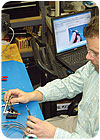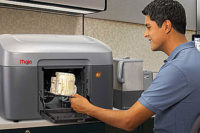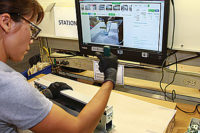
More manufacturers are adopting paperless work instructions, which are often displayed on flat-panel display monitors strategically placed on the plant floor. In fact, the last three recipients of the Assembly Plant of the Year award all use electronic instructions. Lear Corp. (Montgomery, AL), Xerox Corp. (Webster, NY) and Kenworth Truck Co. (Renton, WA) rely on state-of-the-art systems to improve communication and boost productivity on their assembly lines.
Paperless workstations are not an entirely new concept. They have been around for 20 years, primarily in low-volume, complex operations, such as aerospace and defense manufacturing.
Raytheon Missile Systems (Tucson, AZ) pioneered the concept in the mid-1980s, when it launched an initiative to eliminate vast amounts of paper work instructions and improve the control of information. Today, the company has more than 1,000 terminals in place at workstations in several different facilities.
While electronic work instructions are not ideal for every application, new technology has made going paperless easier and more affordable. Two key ingredients, flat-panel display monitors and digital cameras, are readily available today. As the technology behind those devices evolves, the price tag will continue to drop, making it more cost-effective to implement paperless systems on the plant floor.
“We’ve all been told for years that we would eventually be a paperless society,” says David Verrill, applications support manager at IAC Industries Inc. (Brea, CA). “I don’t know if we’ll all see it happen within our lifetimes, but the current trend is certainly a step forward and indicates true benefits for manufacturers of all sizes.”
Until recently, most paperless applications were limited to major corporations that were willing to spend significant amounts of money to stay on the leading edge. “However, I’ve been seeing many more, and much smaller, companies picking up on the paperless concept, especially within the past year,” says Verrill. “While the initial investment can [still] be rather significant, an overall operating savings can be realized.”
The terms “paperless,” “electronic” and “digital” are often used interchangeably to describe work instructions that can be accessed or viewed at a workstation with a computer display. However, the term “visual” work instruction refers to prominently displayed paper work instructions that feature lots of graphics or photos.
“We’re seeing a much stronger push to visual work instructions in every form,” notes Kevin Gingerich, director of marketing services at Bosch Rexroth Corp. (Buchanan, MI). “We see more and more computers being used at factory workstations. And, some of these are for work instructions. But, most of them are integral to the task at hand.
“They may be needed to interact with coworkers at other stations; or the work itself might require computer software to complete,” explains Gingerich. “In many cases, manufacturers will have paper work instructions mounted alongside a computer. It all depends on what’s required for the work.”
Less Paper, More Production
Many manufacturers are discovering that the initial cost of converting to electronic work instructions is worth the return on investment. Major benefits include less paper shuffling, faster communication flow and easier maintenance.Specifically, manufacturing engineers can achieve the following results by going paperless:
- Operator access to real-time production activity data, providing improved visibility into the engineering and production processes.
- Bidirectional communication, yielding fully integrated workflow and shop floor coordination.
- Single-source authority of production information, which enhances data integrity.
- Unified electronic media ensures that standard operations are used in conjunction with standard text to generate standard production plans.
- Disruptions to production due to lost paperwork are minimized.
- Security is enhanced, because proprietary information cannot “walk out” of the plant.
- Seamless integration with quality management systems, which results in timely identification and prevention of product defects.
- Quick dissemination of critical maufacturing information across multiple facilities.
- Up-to-date instructions help avoid production delays, resulting in fewer missed deliveries and increased customer satisfaction.
- Providing the right information at the right time for highly-configured products gives companies the ability to transition from large-batch standard manufacturing to small-batch, highly-configured manufacturing.
- Electronic feedback from the shop-floor enhances continuous improvement and operator consistency.
“Another benefit is that you can design a system using touchscreens that allows workers to complete a step, then touch the screen to go to the next step,” adds Gingerich. “As a result, you can create ‘standard work,’ which is a key ingredient in lean production.”
Paperless systems save a tremendous amount of time and eliminate waste, another lean principle, because information does not have to be manually typed in from hand-written notes. That eliminates double-entry of captured data and eliminates the risk of mistranslating key information.
“The biggest benefit I see is accuracy,” says James Anderson, product manager for the western region at Lista International Corp. (Plano, TX). “With paper, it’s always a challenge to make sure the old versions of instructions are replaced with new, current versions. [By going] paperless, instructions are changed on the network, everyone gets the changes and there are no old versions available."
In addition, centrally-controlled documents ensure consistency in practice, which is extremely helpful during ISO and other quality audits. “You just need to make sure that you have an effective system for updating and changing them as needed,” explains Anderson.
“Revisions to assembly instructions can be made in seconds, minimizing the risk of products being built to prior versions, thus reducing manufacturing cost,” adds David Seay, national sales manager at Sovella-GWS Systems Inc. (Kennesaw, GA). “Changes from engineering to the production floor can take place in seconds. [Electronic work instructions can also be] integrated with part verification systems, ensuring the operator selects, orients and installs each part correctly.”
Successful Applications
Manufacturers in many different industries are going paperless. “We are seeing an increase in the number of applications, specifically in industries where we wouldn’t have expected to see paperless deployments two years ago,” says Barry Lucas, president of Sequence Software Products (Knoxville, TN). Automotive, appliance, electronic and medical device companies are implementing electronic work instructions, in addition to manufacturers of high-tech instruments and windows and doors.“The technology appeals to manufacturers with highly configurable products and companies that have multiple changeovers on their assembly lines,” says Lucas. “Manufacturers in all industries are being [forced] to become more competitive [by reducing] production errors and production costs, and offering more flexibility in products to their customers.”
Computer technology plays a significant role in the on-line production of heavy-duty trucks at Kenworth’s Renton plant. Conventional build paper has been computerized into a chassis image. The paperless system is a user-friendly application with computer stations located every 20 to 30 feet throughout the assembly plant. Employees are able to run a daily build query that provides them with specific parts for their specific area of assembly.
“By eliminating the need to sort through multiple pages of build paper, the opportunity to install the wrong part or miss a required part is lessened,” says Dave Stevens, director of manufacturing engineering. “This on-line version provides more time for the employee to concentrate on the quality of their work and reduces time spent sifting through paperwork.” The system has built-in links to Kenworth’s engineering database if a drawing review is desired by the employee for clarification.
Assemblers at Xerox’s plant in Webster use a computerized system to help streamline the production of digital printing presses. Operators use the system every day for tasks such as following the detailed build steps; correct part usage; correct tool usage; measurement entry and validation; and nonconformance data entry.
Operators can also use the terminals located throughout the plant to find out news such as the birth of a coworker’s baby. In addition, the computers provide continual updates that let workers know how Xerox stock is performing on the New York Stock Exchange.
The ShopFloor system is maintained by planner analysts and manufacturing engineers to ensure that assembly instructions are kept up-to-date and correct, which eliminates variation between machine builds. Also included within the system is a full suite of reports, such as weekly quality reports and assets and their scanned serial numbers.
“A key part of the system is an internal web page that allows the engineers and support staff to communicate directly, in real-time, with all operators on the floor,” says Joao Borges, vice president of worldwide production systems manufacturing. “Implementation of the ShopFloor system has provided many benefits, including: improved quality by allowing us to provide very detailed assembly instructions to the operators; better control of machine configuration changes; and improved traceability.”
Lockheed Martin Aeronautics Co. (Fort Worth, TX) recently developed an electronic work instructions (EWI) project in conjunction with its F-35 joint strike fighter program, which will be ramping up to full production next year. “The overall objective of the project was to update the manufacturing and production operations environment to state-of-the-art technology,” says Brad Leech, EWI senior manager. “[The goals are] to improve data integrity, reduce costs of data generation, increase delivery access and use, enhance user-friendliness on the shop floor and reduce system support costs.
“We recognized an opportunity to update our infrastructure in a way that would increase productivity and reduce both cost and waste,” explains Leech. “We were able to streamline our processes, as well as better organize our various business units into a comprehensive system.” When fully deployed, the system will provide access across the country to more than 6,000 users.
Toyota Motor Corp. (Nagoya, Japan) has also been busy experimenting with paperless work instructions, primarily on certain assembly lines that are high volume and common to multiple facilities. For instance, a version of the popular Camry sedan is built in several different parts of the world.
At the company’s Global Production Center, located in the Motomachi plant in Japan, engineers make a set of electronic work instructions for each workstation and put it in four different languages. Then, at the local plants, the instructions are further adapted to meet local needs.
Potential Drawbacks
Despite all those advantages, paperless work instructions aren’t for everyone. Like any new technology, there are pros and cons that engineers must weigh carefully.Cost is one of the biggest hurdles that needs to be addressed. The initial investment and set up can be expensive and require extra time to train operators.
“Any drawbacks are temporary in nature and are primarily going to be upfront in the establishment of a paperless system,” claims Dave Blatner, head of the aerospace and defense business unit at Visiprise Inc. (Atlanta). “Depending on an organization’s IT infrastructure, a capital investment may be needed for hardware, software and networking enhancements. While this investment may be difficult to justify upfront, the financial and productivity improvements realized long-term have been well-documented within industry.”
In addition to purchasing flat-panel display monitors for each workstation, most manufacturers specify swing-arms equipped with a full range of motion. Beyond that, there are installation costs for the physical components themselves, plus labor to install the necessary network cabling that provides data to the workstations.
“I have seen some customers get around the networking issue by using dedicated CPUs at each workstation, and the idea has its merits in many cases,” says Blatner. “In either instance, outfitting the workstation with the correct accessories, such as utility troughs, cable management and grommeted cutouts can aid in this transition.”
As the average cost of flat-panel monitors gradually falls, paperless work instructions should become more appealing. “All you need is a $400 or $500 computer,” says Jack Hay, vice president of research and development at Sequence Software. In addition, digital cameras, an important data capture and visual reference tool, are relatively inexpensive today.
“However, wherever computers are involved, there are potential problems,” warns Bosch Rexroth’s Gingerich. “What if the screen freezes when you’re trying to load a new document? If you insist on turning the computer off overnight, you have a boot-up sequence to deal with in the morning-which may or may not be time you wish to have employees standing around.
“In a lean environment, you want to minimize the amount of hunting and searching, and this includes sifting through computer directories for the most current version of work instructions,” adds Gingerich. “And, if the computer is fully networked, there are dozens of possible distractions, such as e-mail and Internet web sites. Normally, such distractions are minimal and are a worthwhile trade-off for having a computer-literate workforce. But, they are important factors to consider.”
Hay says those challenges can be easily addressed by invested in thin-client PCs, which do not contain hard drives. “They are very minimal, yet highly configurable,” says Hay, “which makes them ideal for paperless applications on the plant floor.”
Workstation Design
Most workstations can be easily retrofitted, or designed with the correct accessories for accommodating computer display monitors. One of the key challenges of lean workstation design is “making as much productivity happen within the smallest amount of space possible,” explains IAC’s Verrill. “The paperless trend is making that much easier, because less is required at a workstation, allowing for better space allocation for those items that are needed.“If you already have a workstation that was designed for flexibility, the transition may be as easy as removing a document holder or shelf and replacing it with a swing-arm flat panel display, and perhaps a keyboard and mouse holder,” Verrill points out. “However, if you are starting with four legs and a work surface, it may be time for an upgrade.”
Not everyone has to replace existing benches, however. “Depending upon what your goals are, it is often possible to upgrade with a retrofit upright system and the necessary accessories,” says Verrill. “While the overall design doesn’t really change, many people realize that they can reduce workstation size.”
Verrill suggests reviewing what will be required to accomplish the assembly task. “Often, what isn’t essential just creates clutter,” he warns. “Designing for efficiency will always lead to enhanced operator comfort and improved productivity.”
However, whenever there’s a computer display involved, it’s easy to make the mistake of building the workcell around the computer. “The most important thing to remember is that the work cannot be obstructed by the hardware needed for the work instructions,” says Gingerich. “But, that doesn’t mean the monitor should be tucked out of the way. Instead, it means that you should consider a monitor holder that lets you swivel the display into the best position for each worker who will be using a workcell.”
Using an aluminum framing system to construct any workstation is a good idea, because the T-slotted aluminum allows you to position items anywhere along the T-slot and reposition them later. According to Gingerich, another key consideration is lighting in the cell, and how it affects the display’s brightness. “If you previously had brightly illuminated paper work instructions, using the same lighting system may cause glare on some computer displays,” he points out.
“Done correctly, there are countless advantages [to paperless workstations],” concludes Verrill. “Efficiencies can be realized because operator movement is reduced when the necessary information is located directly at the workstation.”


